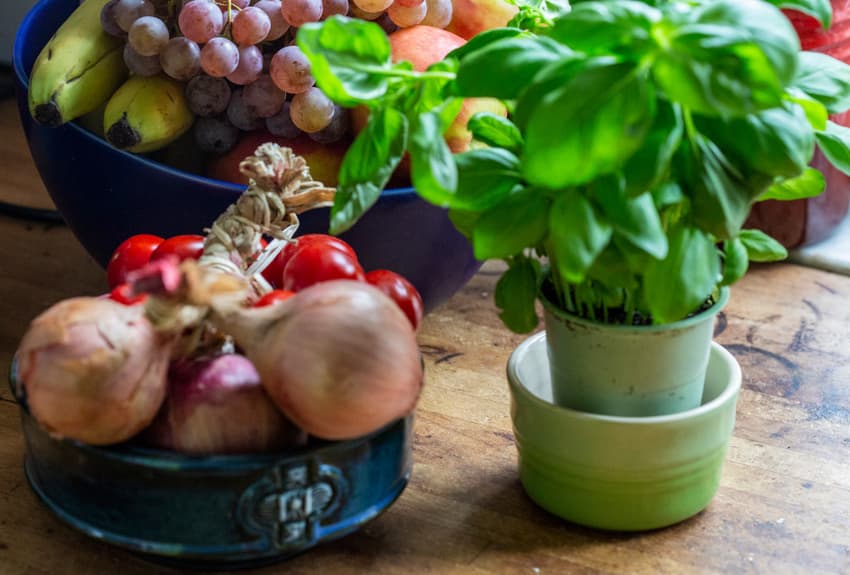Sweden's rising food prices: Which items have increased the most?

Swedish food prices rose in July, with some items seeing a significantly larger increase than others.
After a spring of falling food prices in Sweden, they increased 1.4 percent month-on-month in July, climbing back up to the same levels as in March, according to number-crunchers Statistics Sweden.
READ ALSO:
Yellow onions led the charge, getting a whopping 29 percent more expensive than in June.
Although food prices generally fluctuate throughout the year depending on what’s in season, this was higher than the average 1 percent rise Sweden normally sees in July.
Food and package holidays were some of the main drivers of general price increases in Sweden last month. Offset by falling electricity prices, they contributed to an unchanged overall inflation rate.
Year-on-year, the price of food and non-alcoholic beverages has risen 10.5 percent.
Here are the ten food times that saw the highest month-on-month price increase in Sweden in July (the year-on-year price increase or decrease in brackets):
Yellow onions: 29.2 percent (55.7 percent)
Pears: 23.1 percent (52.7 percent)
Canned herring: 15.6 percent (13.3 percent)
Cucumber: 10.9 percent (-18.7 percent)
Tomatoes: 8.9 percent (39.8 percent)
Oranges: 8.3 percent (25.4 percent)
Butter: 7.6 percent (9.1 percent)
Cod fillets: 7.2 percent (9.5 percent)
Cider: 6.2 percent (13.0 percent)
Carrots: 5.8 percent (34.1 percent)
And here are the top ten food items that got less expensive in July:
Leek: -16.5 percent (64.4 percent)
Mandarin oranges: -15.2 percent (14.4 percent)
White cabbage: -14.8 percent (-1.9 percent)
Cauliflower: -14.4 percent (2.7 percent)
Bell peppers: -10.0 percent (8.2 percent)
Fresh herbs and spices: -3.8 percent (7.3 percent)
Fresh berries: -3.7 percent (23.8 percent)
Salad: -2.7 percent (2.3 percent)
Grapes: -2.2 percent (20.2 percent)
Avocados, mangoes, etc: -2.1 percent (-3.1 percent)
Comments
See Also
After a spring of falling food prices in Sweden, they increased 1.4 percent month-on-month in July, climbing back up to the same levels as in March, according to number-crunchers Statistics Sweden.
READ ALSO:
Yellow onions led the charge, getting a whopping 29 percent more expensive than in June.
Although food prices generally fluctuate throughout the year depending on what’s in season, this was higher than the average 1 percent rise Sweden normally sees in July.
Food and package holidays were some of the main drivers of general price increases in Sweden last month. Offset by falling electricity prices, they contributed to an unchanged overall inflation rate.
Year-on-year, the price of food and non-alcoholic beverages has risen 10.5 percent.
Here are the ten food times that saw the highest month-on-month price increase in Sweden in July (the year-on-year price increase or decrease in brackets):
Yellow onions: 29.2 percent (55.7 percent)
Pears: 23.1 percent (52.7 percent)
Canned herring: 15.6 percent (13.3 percent)
Cucumber: 10.9 percent (-18.7 percent)
Tomatoes: 8.9 percent (39.8 percent)
Oranges: 8.3 percent (25.4 percent)
Butter: 7.6 percent (9.1 percent)
Cod fillets: 7.2 percent (9.5 percent)
Cider: 6.2 percent (13.0 percent)
Carrots: 5.8 percent (34.1 percent)
And here are the top ten food items that got less expensive in July:
Leek: -16.5 percent (64.4 percent)
Mandarin oranges: -15.2 percent (14.4 percent)
White cabbage: -14.8 percent (-1.9 percent)
Cauliflower: -14.4 percent (2.7 percent)
Bell peppers: -10.0 percent (8.2 percent)
Fresh herbs and spices: -3.8 percent (7.3 percent)
Fresh berries: -3.7 percent (23.8 percent)
Salad: -2.7 percent (2.3 percent)
Grapes: -2.2 percent (20.2 percent)
Avocados, mangoes, etc: -2.1 percent (-3.1 percent)
Join the conversation in our comments section below. Share your own views and experience and if you have a question or suggestion for our journalists then email us at [email protected].
Please keep comments civil, constructive and on topic – and make sure to read our terms of use before getting involved.
Please log in here to leave a comment.